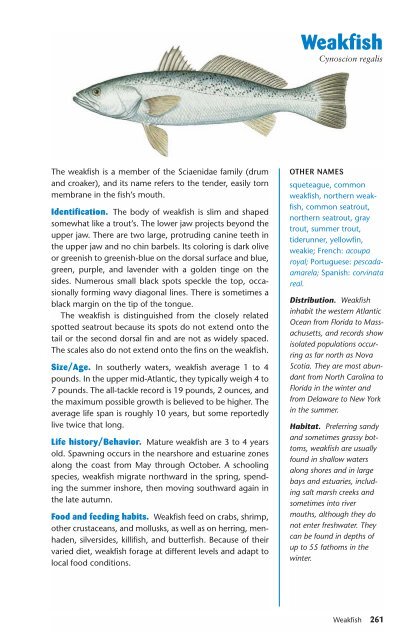Ken Schultz's Field Guide to Saltwater Fish - Macaw Pets store
Ken Schultz's Field Guide to Saltwater Fish - Macaw Pets store
Ken Schultz's Field Guide to Saltwater Fish - Macaw Pets store
You also want an ePaper? Increase the reach of your titles
YUMPU automatically turns print PDFs into web optimized ePapers that Google loves.
The weakfish is a member of the Sciaenidae family (drum<br />
and croaker), and its name refers <strong>to</strong> the tender, easily <strong>to</strong>rn<br />
membrane in the fish’s mouth.<br />
Identification. The body of weakfish is slim and shaped<br />
somewhat like a trout’s. The lower jaw projects beyond the<br />
upper jaw. There are two large, protruding canine teeth in<br />
the upper jaw and no chin barbels. Its coloring is dark olive<br />
or greenish <strong>to</strong> greenish-blue on the dorsal surface and blue,<br />
green, purple, and lavender with a golden tinge on the<br />
sides. Numerous small black spots speckle the <strong>to</strong>p, occasionally<br />
forming wavy diagonal lines. There is sometimes a<br />
black margin on the tip of the <strong>to</strong>ngue.<br />
The weakfish is distinguished from the closely related<br />
spotted seatrout because its spots do not extend on<strong>to</strong> the<br />
tail or the second dorsal fin and are not as widely spaced.<br />
The scales also do not extend on<strong>to</strong> the fins on the weakfish.<br />
Size/Age. In southerly waters, weakfish average 1 <strong>to</strong> 4<br />
pounds. In the upper mid-Atlantic, they typically weigh 4 <strong>to</strong><br />
7 pounds. The all-tackle record is 19 pounds, 2 ounces, and<br />
the maximum possible growth is believed <strong>to</strong> be higher. The<br />
average life span is roughly 10 years, but some reportedly<br />
live twice that long.<br />
Life his<strong>to</strong>ry/Behavior. Mature weakfish are 3 <strong>to</strong> 4 years<br />
old. Spawning occurs in the nearshore and estuarine zones<br />
along the coast from May through Oc<strong>to</strong>ber. A schooling<br />
species, weakfish migrate northward in the spring, spending<br />
the summer inshore, then moving southward again in<br />
the late autumn.<br />
Food and feeding habits. Weakfish feed on crabs, shrimp,<br />
other crustaceans, and mollusks, as well as on herring, menhaden,<br />
silversides, killifish, and butterfish. Because of their<br />
varied diet, weakfish forage at different levels and adapt <strong>to</strong><br />
local food conditions.<br />
Weakfish<br />
Cynoscion regalis<br />
OTHER NAMES<br />
squeteague, common<br />
weakfish, northern weakfish,<br />
common seatrout,<br />
northern seatrout, gray<br />
trout, summer trout,<br />
tiderunner, yellowfin,<br />
weakie; French: acoupa<br />
royal; Portuguese: pescadaamarela;<br />
Spanish: corvinata<br />
real.<br />
Distribution. Weakfish<br />
inhabit the western Atlantic<br />
Ocean from Florida <strong>to</strong> Massachusetts,<br />
and records show<br />
isolated populations occurring<br />
as far north as Nova<br />
Scotia. They are most abundant<br />
from North Carolina <strong>to</strong><br />
Florida in the winter and<br />
from Delaware <strong>to</strong> New York<br />
in the summer.<br />
Habitat. Preferring sandy<br />
and sometimes grassy bot<strong>to</strong>ms,<br />
weakfish are usually<br />
found in shallow waters<br />
along shores and in large<br />
bays and estuaries, including<br />
salt marsh creeks and<br />
sometimes in<strong>to</strong> river<br />
mouths, although they do<br />
not enter freshwater. They<br />
can be found in depths of<br />
up <strong>to</strong> 55 fathoms in the<br />
winter.<br />
Weakfish 261


